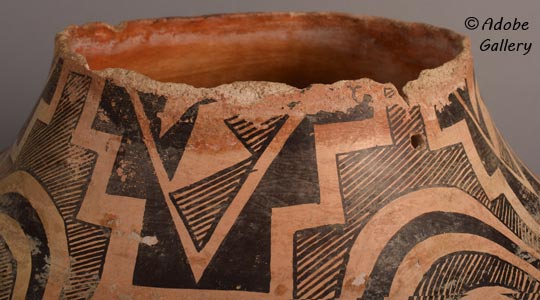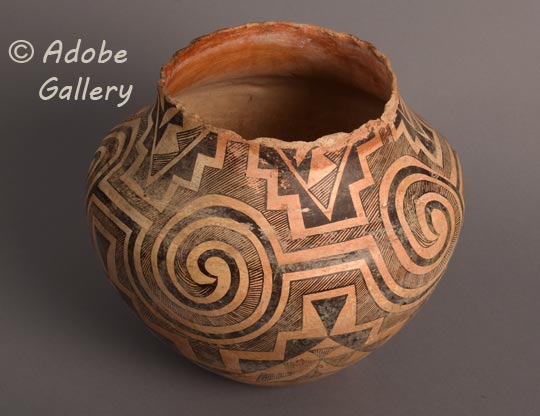Nineteenth Century Acoma Pueblo OLLA with Tularosa Design
+ Add to my watchlist Forward to Friend
Forward to Friend
- Category: Historic
- Origin: Acoma Pueblo, Haak’u
- Medium: clay, pigment
- Size: 12" tall x 13-1/2" diameter
- Item # C4861A
- Price: $16500
In the waning days of the 1800s, potters at Acoma Pueblo began reviving designs from ancient pottery. In particular, one design became the most popular. It was the reuse of pottery designs from the mid-1200s, known as Tularosa Black-on-white, which had been made in the region of present-day Acoma Pueblo. [Lanmon & Harlow: 2013:375] Acoma Pueblo potters claimed the inherited right to use designs of the earlier Puebloan groups that lived in their region. Acoma potters have been particularly involved with the use of these designs since the late 19th century.
The Tularosa Basin is in the area east of the Rio Grande in southern New Mexico, mostly in Otero County. It lies between the Sacramento Mountains to the east and the San Andres and Oscura Mountains to the west. Notable features of the Tularosa Basin are White Sands National Monument, Trinity Site, and the Carrizozo lava flows.
This Acoma jar is an excellent example of the use of Tularosa patterning. The curvilinear scrolls that circumnavigate the mid body are flanked on the upper and lower extremities with rectangular and triangular stepped black-on-white designs. Throughout, these designs are very fine hatching lines that fill the previously undecorated white areas. As was the Tularosa tradition, the design elements are close together, solids are heavy, and hatching lines are very fine.
This jar is larger than average water jars and thereby provided space for fully developing the intricate designs. The jar was made for use at the pueblo as evidenced by the worn clay body near the rim, which was originally scalloped. Most areas of the scallop rim still exist. The jar was used as a water jar, thus the eventual accumulation of calcium deposits on the exterior as the water evaporated through the vessel walls. The combination of calcium deposits and rim erosion indicate a rather long-term use of the jar. The jar dates to the late 1800s.
This is one of the most attractive styles ever produced by the Acoma potters. As black and white photographs often are stronger in appeal than color photographs (see Ansel Adams), so too are some of the black and white pottery that is often overlooked by collectors in preference to three- and four-color examples. This jar is an excellent example to illustrate this point.
Condition: good condition with natural wear patterns from decades of use as a water jar.
Provenance: this Nineteenth Century Acoma Pueblo OLLA with Tularosa Design is from the collection of a client of Adobe Gallery
Reference: The Pottery of Acoma Pueblo, Figure 26.10, page 532. Francis Harlow and Dwight Lanmon
TAGS: Southwest Indian Pottery, Acoma Pueblo, Historic Pottery


- Category: Historic
- Origin: Acoma Pueblo, Haak’u
- Medium: clay, pigment
- Size: 12" tall x 13-1/2" diameter
- Item # C4861A
- Price: $16500
Adobe Gallery Recommended Reading
Adobe Gallery Recommended Items
If you are interested in this item, we would also like to recommend these other related items:



